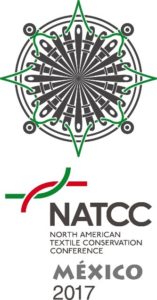
by Michelle Hunter, 2016 graduate.
I was recently able to attend the 11th North American Textile Conservation Conference (NATCC), which is held every two years to share ideas and advancements in the field of textile conservation. Each conference has a different theme and the theme of this one was ‘Embellished Fabrics: Conserving Surface Manipulation and Decoration’. The conference was held at the Escuela Nacional de Conservación, Restauración y Museografía (ENCRyM) in Mexico City.
Over two days, 21 papers and 11 posters were presented from 8 different countries that highlighted embellished textiles and related materials ranging from archeological to modern materials to upholstery. Papers were delivered in both Spanish and English with simultaneous translation provided.
The conference started off with papers highlighting new understanding of embellishment of Pre-Columbian and Pre-Hispanic textiles. Dra. María de Lourdes G. Gallardo Parrodi from the Museo del Templo Mayor- INAH presented a paper in which she discussed the use of shell as an embellishment on Pre-Hispanic Mesoamerican ritual garments. As the textile elements of these garments rarely survive archeological conditions, reconstructions were made to understand construction techniques. These reconstructions illustrated not only the aesthetics of these garments but the impressive sound they made upon movement, which was part of their significance.
Several of the presentations dealt with the challenges of conserving embellished textile objects. Ana Lizeth Mata Deladgo and Claudia María Coronado García of Seminario Taller de Restauración de Obra Moderna Contemporánea (STROMC) and ENCRyM discussed the issues concerning a contemporary ‘soft sculpture’ by Noemí Ramírez embellished with coconut fibre and palm tree elements. The ‘soft sculpture’ of a man’s face was originally created to be ephemeral and conservators were faced with the challenge of reversing his demise through conservation. Lynn McClean of National Museums Scotland was challenged by the treatment of a highly ornate 17th century chasuble with areas of loss on the highly pronounced embellishments. This treatment required collaboration with paper conservation colleagues to develop an appropriate technique to compensate for areas of loss.
Ana Lizeth Mata Deladgo and Claudia María Coronado García of Seminario Taller de Restauración de Obra Moderna Contemporánea (STROMC) and ENCRyM discussed the issues concerning a contemporary ‘soft sculpture’ by Noemí Ramírez embellished with coconut fibre and palm tree elements. The ‘soft sculpture’ of a man’s face was originally created to be ephemeral and conservators were faced with the challenge of reversing his demise through conservation. Lynn McClean of National Museums Scotland was challenged by the treatment of a highly ornate 17th century chasuble with areas of loss on the highly pronounced embellishments. This treatment required collaboration with paper conservation colleagues to develop an appropriate technique to compensate for areas of loss.
Ever more pressing is the need for conservators to understand and adapt treatments for the preservation of modern materials. Leanne Tonkin of the Costume Institute at The Metropolitan Museum of Art presented a case study of two identical c. 1938 cellulose acetate belts designed by Elsa Schiaparelli each in very different condition. They were comparatively studied and each belt underwent extensive analytical investigation, and mechanical fractures along with degradation products were noted in the more degraded belt. Elizabeth-Anne Haldane of the Victoria and Albert Museum presented work on conserving cellophane materials. She explored the history of cellophane and presented several case studies, one of them to find a suitable and sympathetic repair material to blend with the shiny cellophane surface of a 1950s Cristóbal Balenciaga headpiece.
Throughout the conference what stood out most to me were the varied materials textile conservators can be charged with caring for and the often complex and unique interventions required to prolong the life of the object. Each presentation and poster provided the delegates with a new insight into an embellishment material and imparted new knowledge that we can call upon if we are ever faced with a similar object.
NATCC was not only an excellent learning experience by it was a great opportunity to meet other graduates and classmates from the University of Glasgow Centre for Textile Conservation. Seven of us travelled from Canada, United States, Great Britain, and New Zealand to attend the conference. It was great to catch up with everyone and hear about the projects they are working on.

I’m looking forward to attending the next NATCC which will be held in the conference’s inaugural location of Ottawa, Canada in September 2019.
I would like to thank Tru-Vue and the Canadian Association for Conservation for their generous support which allowed me to attend this conference.

